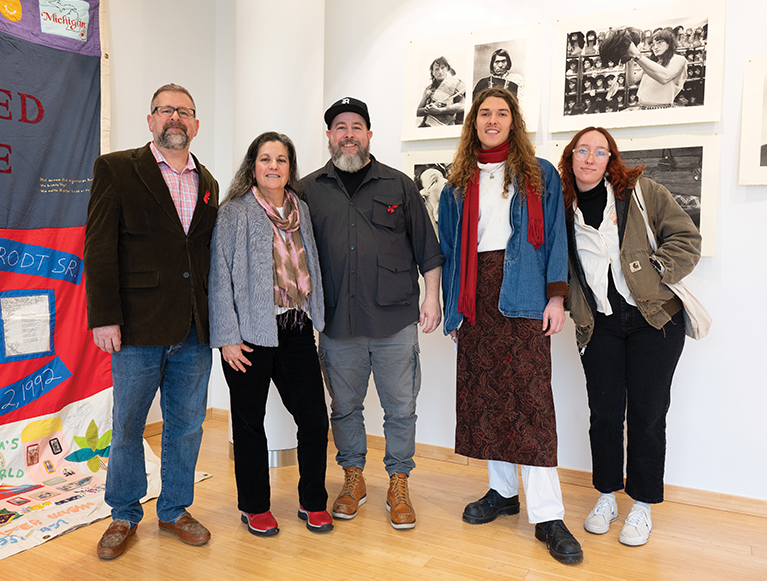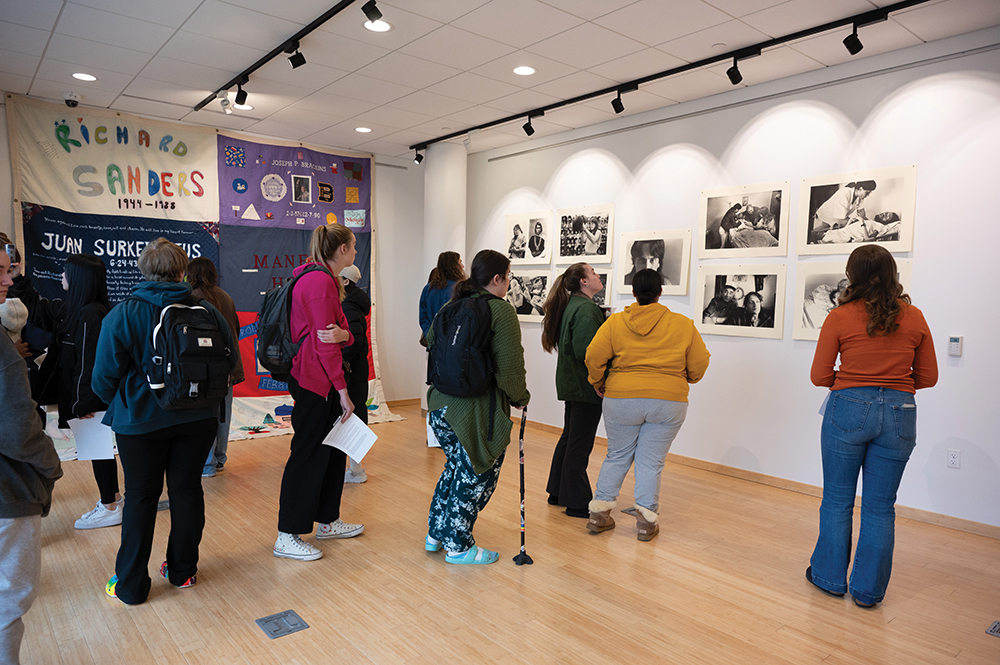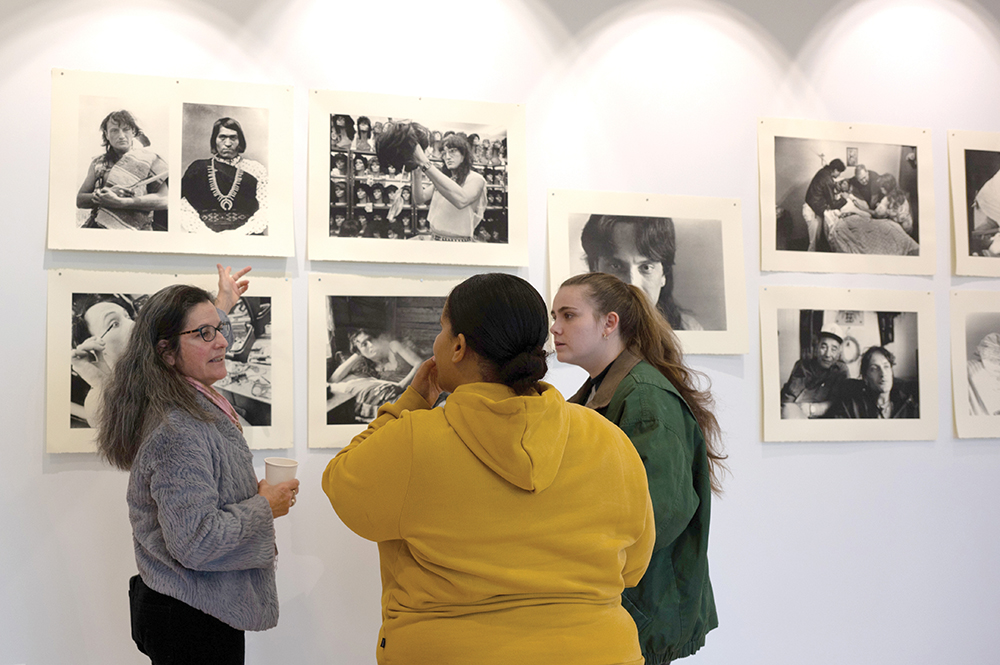Fine Arts professors bring awareness of World AIDS Day to campus with Cooley Gallery Exhibit
By Deanna Thompson
When Therese Frare arrived at Ohio University in 1990 to pursue a master’s degree in visual communications, she had no idea that, within months, she would capture an image that would be seen by an estimated billion people around the world and described as “the photo that changed the face of AIDS.”
That image, showing the last moments of an AIDS patient named David Kirby, was published by LIFE magazine in November 1990, and credited with humanizing AIDS patients, who at the time were often ostracized by others.
Today, more than 30 years later, that iconic image is one of the screen prints included in “Remembering Two Spirits: The Photos of Therese Frare,” an exhibition that opened on Dec. 1, 2023, World AIDS Day, in the Cooley Gallery at Wilson College. In addition to Frare’s well-known image, the exhibition includes powerful images of another AIDS patient known as Peta, whose right arm can be seen in the famous photo as he helps care for Kirby. After Kirby’s death, Frare followed Peta (born Patrick Church) over a period of two years, documenting moments in his life and end of life for her thesis project at Ohio University.
The genesis of the show
The exhibition of Frare’s images at Wilson College came about after Adam DelMarcelle, assistant professor of Graphic Design, reached out to Frare about including her famous picture of Kirby in a collection he was assembling of major art pieces in the realm of social justice. As they continued their conversation, he learned about her photos of Peta. Like Kirby’s photo, the images of Peta help tell the story of the AIDS epidemic in the 1990s, but they also touch on other issues that are front and center today.

Professors Joshua Legg, M.F.A. and Adam DelMarcelle are joined by Therese Frare, Ryan Rinehardt ‘25, and Faith Crawford ‘26 at the opening of the “Remembering Two Spirits: The Photos of Therese Frare” exhibit.
In her artist’s statement for the exhibition, Frare notes that the photos of Peta explore “life in a pandemic, the issues of multiracial heritage, and the fluidity of gender identity. Does this sound familiar? These topics are still very relevant today. In this project, I was looking for the blurred lines between male and female, between White and Native American, and between being a caregiver and being the one who needs care.”
After DelMarcelle saw the photos, it was clear to him that the portfolio focused on issues that were important to explore.
“Not only is it about HIV/AIDS, but it’s about the indigenous population, it’s about gender,” DelMarcelle said. “It’s so relevant to right now, maybe even more so than it was when she took the photographs. So, I asked her, … I want to do something with this. Maybe we could do an exhibition.”
Frare was intrigued, and so was Joshua Legg, Wilson’s associate dean for Academic Affairs, director of the Master of Fine Arts program, and curator of the Cooley Gallery. His goal as gallery curator is to feature the work of living artists and provide opportunities for students to have a dialogue with them. A longtime AIDS activist, Legg vividly remembered Frare’s photo of Kirby, showing a gaunt, dark-haired man looking into the distance, cradled by his father as other family members look on.
“I remembered that image from when it was released back in the 1990s and the impact that it had on the conversation, the dialogue around HIV/AIDS at the time,” Legg said. “And I was like, yes, let’s do an exhibition. We looked at when we were going to open the show, and I knew I wanted it to be on World AIDS Day.”
Creating the exhibition
As DelMarcelle and Frare discussed the exhibit, he told Frare that instead of simply showing her photographs, he would like to go a step further.
“Why don’t I take your photographs and turn them into screen prints? And she was interested in that idea,” DelMarcelle said. “What she did for me is, she sent me physical prints. I made really high- quality scans of the physical prints. Then I could turn those into screen prints from the digital images. It’s all hand- done, a hand process.”
DelMarcelle selected 17 of Frare’s photos for the exhibition, creating screen prints measuring 22 by 30 inches. He used dirt taken from the site of the hospice home where Kirby and Peta met to make the ink he used in the screen prints. (For more on this, see story on The Beauty of Art.) Viewers of the exhibit can see Frare’s iconic image of Kirby and his family, but also numerous prints of Peta, showing the dualities in his life.
The title of the exhibition, “Remembering Two Spirits,” refers to that duality, specifically Peta’s Native American ancestry – he was half Native American and half-White – and his blurring of the lines in gender.
“Two Spirits is used to describe indigenous people who embody both a feminine and masculine energy and have traditionally held a number of important social and spiritual roles in their tribes,” Frare wrote in her artist statement.
In addition to the screen prints, DelMarcelle wanted the exhibition to include a panel from the AIDS Memorial Quilt, a project started in 1987 that today includes the names of 110,000 people who died of AIDS on over 50,000 hand- sewn panels, each the size of a burial plot. He approached the nonprofit that manages the quilt and asked if there was a panel with Peta’s name.
“I thought that would be a long shot,” DelMarcelle said. “But sure enough, Peta was on one of the panels.” DelMarcelle arranged to have that section of the quilt sent for the exhibit.
“Not only do we have this whole gallery full of images of Peta made with the dirt of the ground that they walked, now we also have the AIDS quilt panel that was made for him after he passed away,” DelMarcelle said.
The exhibition
The show opened on the 35th annual World AIDS Day, an event created in 1988 to raise awareness about HIV/AIDS and honor those who were affected. At Wilson, the day’s events included a panel discussion among Frare, DelMarcelle, and Legg about the exhibition and World AIDS Day, followed by the opening of the show.
“It’s probably one of the best attended events that we’ve had,” Legg said. “And the feedback from students, staff, faculty, everyone, both about the conversation and the exhibition itself – it was incredibly well received. I continue to hear from people who stop by the exhibition. It [the exhibition] is very moving and a little overwhelming.”
Although HIV cases and AIDs-related deaths have declined dramatically since the first World AIDS Day, the opioid epidemic combined with the COVID pandemic to fuel increases in recent years, Legg noted. In 2022, 1.3 million people became newly infected with HIV and 630,000 people died from AIDS- related illnesses worldwide, according to The Joint United Nations Programme on HIV/AIDS (UNAIDS) organization.
“One of the reasons why I think it’s important for us to have this dialogue here at Wilson and in this region is that for a while, HIV infection rates had shifted globally to developing nations,” Legg said. “The developed world has, since the COVID pandemic, seen a marked increase in cases.
That’s particularly true in rural areas and places that are economically challenged. So, this was an opportunity to bring the subject matter back to our community’s awareness.”
“Remembering Two Spirits: The Photos of Therese Frare” is on display through March 15. The exhibition is open to the public as well as students, faculty, staff, and alumni of the College.
The Artist
Therese Frare on How the Photos Came About
Therese Frare had worked as a newspaper photographer for more than a decade when she decided to return to graduate school in January 1990 at Ohio University, where she hoped to create a documentary project about a subject that interested her: the developing HIV/ AIDS epidemic. Very quickly, she found obstacles in her path.
When she approached AIDS organizations in the rural area around Ohio University, none would allow her to photograph patients. She branched out to Columbus, a much bigger city an hour- and-a-half drive away, and approached the Pater Noster House, a hospice home for AIDS patients.
They initially said no as well but encouraged Frare to volunteer at the hospice. She did, making the drive from Athens to Columbus every week or so, with no guarantee she would ever be able to take photos there, she recalls.
“When you’re staff at a newspaper, you can’t invest a lot of time in a ‘no’ or a ‘maybe’,” she said. “[But as a student at the time] I think I just decided, okay, I’m interested anyway, and I have time, and I’ll just volunteer. I think it actually came as a bit of a surprise to me, to tell you the truth, how it all unraveled.”
The “unraveling” that led to her iconic photo of David Kirby began a couple months after she started volunteering. Pater Noster House allowed a television crew to film at the hospice, prompting them to relent and allow Frare to shoot photos as well. During her visits as a volunteer, Frare had become friends with Peta, then HIV-positive and later an AIDS patient, who helped care for Kirby. She also had spent time with Kirby, who gave Frare permission to take pictures of him as long as the images were not used for personal gain. She was at the hospice outside his room on May 5, 1990, the day of his death, when his mother came out and asked Frare to document the family’s goodbyes. Frare took her place in a corner of the room and shot photos.
It wasn’t until Frare went into the darkroom to develop the roll of black- and-white film that she realized what she had captured.
“Back then we had film, so there wasn’t that instant feedback of the image. And it took me a while to get around to processing the film, maybe a week or so,” Frare recalled. “And then when I saw the negative, it was like, wow. I could tell it was a picture for sure at that point, which is what made me send it to LIFE magazine.”
Her picture not only appeared in the November 1990 issue of LIFE but also won two World Press Photo Awards in 1991: second place in General News, and the Budapest Award, a special humanitarian award for understanding relationships among people. A colorized version later was used with the Kirby family’s encouragement in a controversial ad campaign by the global fashion brand Benetton.
While that photo has taken on a life of its own, it is her images of Peta that Frare is especially drawn to as a photographer. After Kirby’s death, Frare spent two years capturing moments in Peta’s life for her thesis project. In addition to photographing him in everyday life at the hospice, she accompanied him to Rosebud Reservation in South Dakota where, she says, “we were guests of his uncle, the medicine man and tribal chief.” She also documented in photographs Peta’s last days, when he was cared for by Kirby’s family, just as he had cared for Kirby.
Frare was happy to have her compelling images of Peta – recreated as screen prints by DelMarcelle – featured in the exhibition at Wilson.
“The photos of Peta have been seen, but definitely not as much [as the Kirby photo],” she said.
In addition to participating in a panel discussion about the exhibit while at Wilson, Frare met with students in art history, sociology, and drawing classes to discuss her pictures and the stories behind them in detail.




